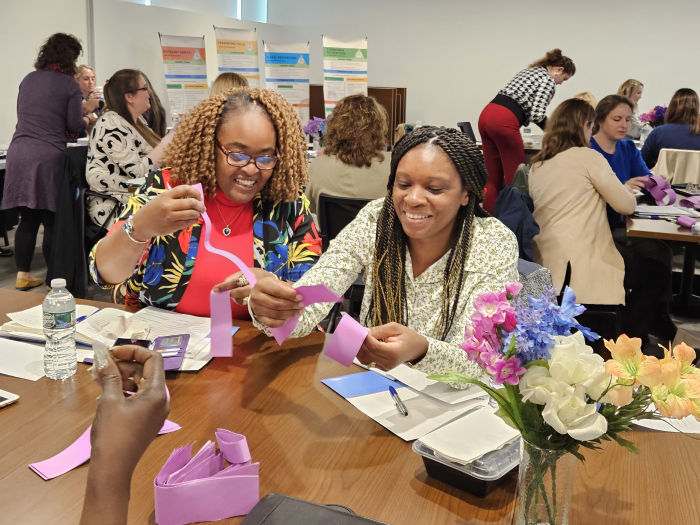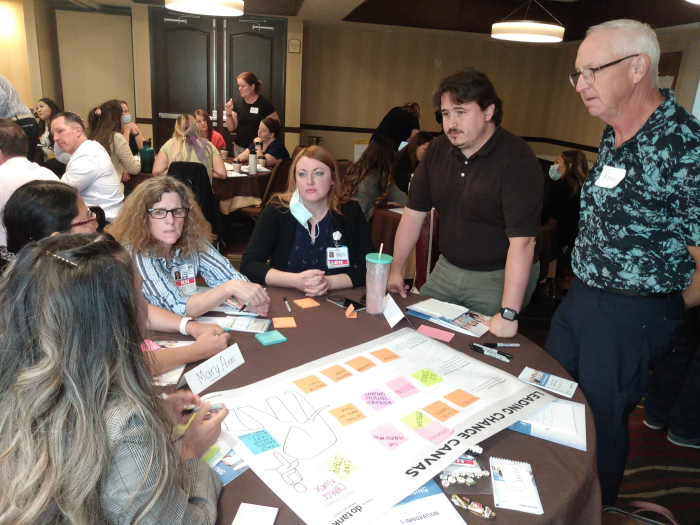
Our TeamSTEPPS Curriculum
AHA Team Training’s exclusive TeamSTEPPS Master Training course curriculum is ever evolving and includes the most up-to-date innovations in the field including TeamSTEPPS 3.0 and human-centered design thinking.
TeamSTEPPS is an evidence-based set of teamwork and communication tools designed to optimize team performance and ultimately improve patient outcomes, increase staff and patient satisfaction, foster workforce well-being and support change management efforts. Our TeamSTEPPS Master Training course will teach participants all the TeamSTEPPS tools and principles - what they are, how to use them, and how to implement them. Participants will gain skills and resources for training others and facilitating a TeamSTEPPS rollout to create meaningful and lasting culture change.
Ready to Dive Deeper into TeamSTEPPS?
Check out current course offerings or learn more about our custom advisory services
What Makes Our TeamSTEPPS Master Training Course Unique?
Our People
We partner with interprofessional faculty teams of experienced clinical and non-clinical health care professionals who are experts at teaching, using and implementing TeamSTEPPS
Our Curriculum
We teach using an innovative curriculum coupling TeamSTEPPS 3.0 tools with exclusive human-centered design thinking exercises, resulting in a learning experience that helps translate ideas into solutions
Our Approach
Participants walk away with an actionable implementation plan that is both manageable and scalable, fostering program ownership and providing pragmatic next steps for sustainable success
Our Resources
Gain full access to a living suite of AHA Team Training resources, including customizable slide decks, companion worksheets, and facilitation guides for organizational use and customization
TeamSTEPPS is a great example of how teamwork, respect, and mindful communication can and DOES make an incredible impact not only on patient outcomes, but on the psychological safety of the entire health care team.
The TeamSTEPPS tools have been relatively easy to fold into our practices without creating additional work, which is really important, especially in the current environment. As a result of this program, we have seen positive cultural changes that promote open communication.
Overall, this training program was a transformative experience. It not only equipped me with new skills and knowledge but also inspired a passion to want to educate others.
TeamSTEPPS Master Training Course Curriculum Overview
Our curriculum reduces didactic lecture and increases experiential learning by using multiple modalities such as low-tech simulation, group discussion, and video clips. On Day 1, participants will learn the TeamSTEPPS 3.0 tools and how to apply them in both clinical and non-clinical settings to overcome communication and teamwork related challenges. Didactic knowledge is combined with opportunities to practice tools and skills, leading participants to apply learnings to real-life challenges. On Day 2, participants utilize human-centered design thinking exercises to construct a strategic and tactical plan to teach, coach, measure and implement TeamSTEPPS at their organization. These exercises start with design thinking canvases developed exclusively for AHA Team Training courses. Each canvas is structured to help participants lead strategic conversations, brainstorm innovative ideas, and design impactful change.
Day 1 Content
- Introduction & Setting the Stage — finding the “why” behind the work of team training so that patients and care teams achieve exceptional outcomes
- Communication — effectively exchange information among team members, regardless of message modality
Tools you can use: Closed Loop Communication | SBAR | Call-Out | Teach-Back | I-PASS - Leading Teams — direct and coordinate, assign tasks, motivate team members, facilitate optimal performance
Tools you can use: Brief | Huddle | Debrief - Mutual Support — anticipate and support team members’ needs, provide feedback, advocate for the patient by voicing concerns
Tools you can use: Task Assistance | DESC Script | CUS | Advocacy and Assertion | Formative Feedback | Two-Challenge Rule | - Situation Monitoring — develop common understanding of the team environment, apply strategies to monitor performance, maintain a shared mental model
Tools you can use: Cross-Monitoring | STEP | I'M SAFE | STAR - TeamSTEPPS Training Design — Discover successful elements for facilitating shorter, abbreviated TeamSTEPPS Essentials courses back at your organization, including tips for facilitation
- Training Design Criteria canvas: identify a strategy for your own TeamSTEPPS training and facilitation


Day 2 Content
- TeamSTEPPS Tools Review — engage in games, practice teaching, or other interactive activities to test your new found knowledge!
- Measuring Success — identify qualitative and quantitative measures that connect into your team’s “why” and can be used to assess the impact of TeamSTEPPS on your challenge or opportunity
- Inform Your Why canvas: explore current data, review collection efforts and create necessary measures to inform TeamSTEPPS strategy
- Building Ownership and Engagement — outline the purpose and importance of change teams, identify key stakeholder roles and strategies to address resistance
- Stakeholders canvas: understand the motivations and needs of stakeholders to be engaged, influenced and impacted by change
- Leading Change — strategize how to motivate and manage change, operationalizing the behaviors needed to successfully implement TeamSTEPPS
- Change Management canvas: develop preliminary tactics on how to direct and motivate stakeholders who are experiencing change
- Implementation — develop a strategic and tactical TeamSTEPPS implementation plan based on outputs from the course work and canvases
- TeamSTEPPS Gameplan canvas: start to create a project plan that will help reach incremental milestones
- TeamSTEPPS Marketplace — practice presenting and assessing TeamSTEPPS plans in small groups to gather feedback and gain new ideas


Virtual vs. In-Person TeamSTEPPS Course Formats
In 2021, we developed our virtual TeamSTEPPS Master Training course format based on several guiding principles: 1) health care professionals need access to flexible learning options that work with busy schedules; 2) live online workshops should be focused on active learning – engaging directly with faculty and peers and learning how to apply tools and skills to a variety of situations; and 3) knowledge transfer is most effective when participants can immediately apply what they learn to their work. With those principles in mind, our virtual TeamSTEPPS Master Training course combines weekly interactive workshops with highly flexible self-paced learning over an 8-week period.
What's the same between our virtual and in-person courses? The TeamSTEPPS content.
What's the difference? The delivery mode.
Participants in both course formats will be taught the TeamSTEPPS tools and supported in project-based learning for the development of their own TeamSTEPPS plans. Whether it's over the course of two days or eight weeks, attending a TeamSTEPPS Master Training course provides multiple opportunities to practice using TeamSTEPPS skills, apply new learnings to real-life challenges, and network with other teams to share ideas and solutions.
TeamSTEPPS Success Stories
Looking for proof of concept? Each TeamSTEPPS Success Story provides insight into approaches and goals, outlines actions taken, and shares recommendations for success from diverse TeamSTEPPS perspectives.

